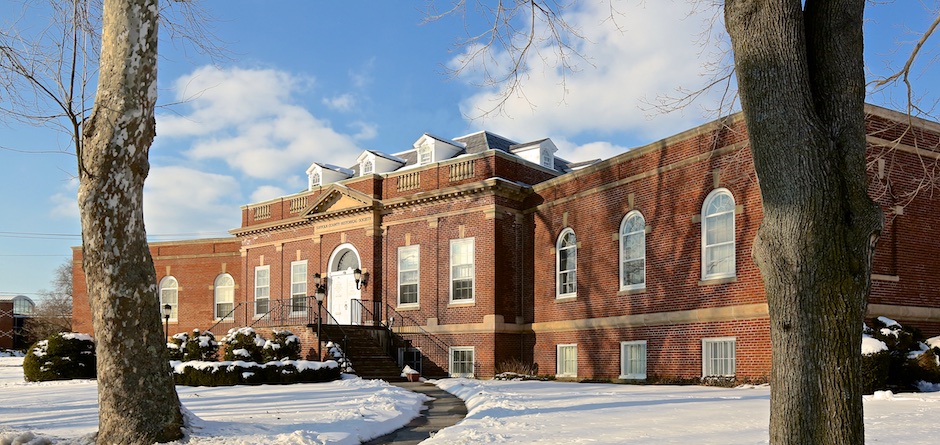
SUFFOLK COUNTY HISTORICAL SOCIETY
~~~~~~~~~~~~~~~~~~~~~~~~~~~~~~~~~~~~~
MEMBERSHIP DRIVE
If you’ve been enjoying our Photo of the Week, please consider becoming a member of SCHS. The Suffolk County Historical Society, founded in 1886, collects and preserves the rich history of Suffolk County and beyond. We offer a history museum, art galleries, a research library and archives, and a multitude of exhibits, programs, and educational lectures and workshops year-round. Our unique collections reflect more than three centuries of Long Island history.
Click here to learn about Member Benefits!
—————————-
From the Civil War to civil rights, revolutions to restorations, spies to Suffragettes, boatbuilders to bootleggers, and whalers to wineries, Long Island’s history comes alive at the Suffolk County Historical Society!
Interested in seeing more historical photos from the Collection of the Suffolk County Historical Society? Spend an afternoon at our Local History Library perusing our extensive archival photography collections. We’re open Weds. – Sat., 12:30 – 4:30 PM.
*****************************

~~~~~~~~~~~~ DECEMBER 2021 ~~~~~~~~~~~~
—————————————
Photo of the Week
———— December 20, 2021 ————
FROM THE SCHS LIBRARY ARCHIVES
“How shall we know it is us without our past?”
– John Steinbeck
~~~~~~~~~~~~~~~~~~~~~
Lloyd Harbor Lighthouse, c. 1905
by Wendy Polhemus-Annibell, Head Librarian
********
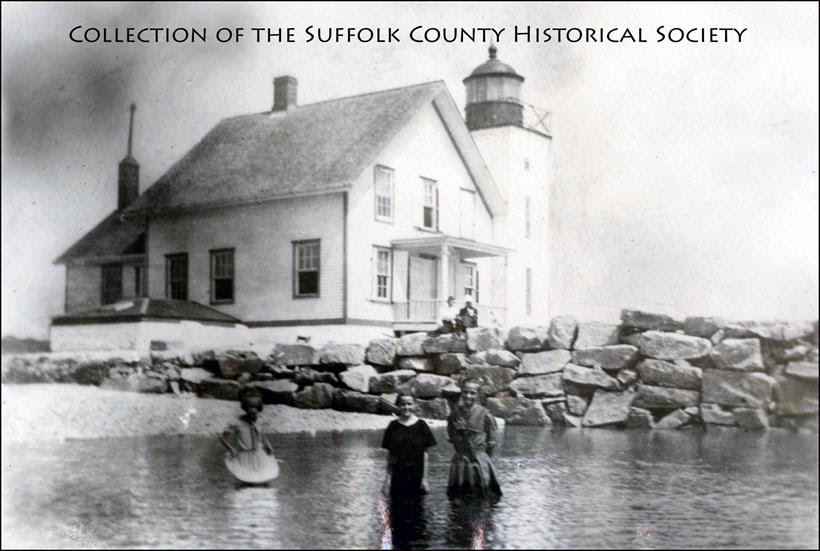
Original Lloyd Harbor Lighthouse, c. 1905. (Image from the Huntington Town Pictorial Collection of the Suffolk County Historical Society Library & Archives. Copyright (c) Suffolk County Historical Society. All rights reserved.)
The original Lloyd Harbor Lighthouse was constructed in 1857. It consisted of a two-story, wood-frame dwelling built on a brick foundation and was attached at one corner to a square brick tower. A kitchen, dining room, and sitting room were located on the first floor, and three bedrooms were available on the second floor. The original beacon was a fifth-order, Henry-Lepaute Fresnel lens showing a fixed white light at a focal plane of forty-eight feet. The first keeper listed for Lloyd Harbor Lighthouse was John S. Woods. He was replaced by Abiathar Johnson in 1875, and by Robert McGlone in 1885.
This Lloyd Harbor Lighthouse was eventually replaced by the Huntington Harbor Light, which was built in a nearby spot in Huntington Bay. In 1947, the original Lloyd Harbor Light that had stood for more than ninety years was lost in a fire.
******************************

Photo of the Week
———— December 13, 2021 ————
FROM THE SCHS LIBRARY ARCHIVES
“How shall we know it is us without our past?”
– John Steinbeck
—————-
Oysterponds | Orient, 1640
by Wendy Polhemus-Annibell, Head Librarian
********
Orient Alfalfa Field, 1909, by Hal B. Fullerton. (Image from the Harry T. Tuthill Fullerton Collection of the Suffolk County Historical SocietyLibrary Archives [149.7.567]. Copyright © Suffolk County HistoricalSociety. All rights reserved.) [To view Fullerton photo, please visit www.suffolkcountyhistoricalsociety.org]
The community of Orient occupies the easternmost portion of the North Fork of Long Island. Both the community and the village of Orient were formerly called Oysterponds. Earlier, Poquatuck was the Indian name for the whole area of Oysterponds. At one time, the area included East Marion, known as Oysterponds Upper Neck, while Orient was called Oysterponds Lower Neck. The name was changed to Orient in 1836 to signify the area’s eastern position on Long Island.
Oysterponds (Orient) was within the area claimed by the early settlers of Southold in 1640, which included all the lands from Wading River and Riverhead to Oysterponds Point and Plum Island. The year 1661 is generally accepted as the time when Oysterponds was permanently settled. In that year it was “agreed and confirmed by a major vote that all common lands at Oysterponds, Occabauk, and Mattatuck should be surveyed and layed out to every man his due proportion in each place.”
Oysterponds was thus divided into 40 lots to John Youngs, Thomas Moore, Lieutenant Glover, Richard Brown, Thomas Moore, John Herbert, John Payne, Mrs. Youngs (widow), John Conkling Sr., John Corey, Thomas Osmond, Thomas Conklin, Geoffrey Jones, Abram Whittier, and Thomas Rider. The number of lots each received was determined by the amount of contribution to the initial Southold settlement. A single lot was 50 acres, and the original lots were generally laid out so that they were bounded on the north by the Sound and on the south by the bay. A road was later laid out through the middle of Oysterponds and it was named King’s Highway (today’s Main Road).
Suggested Reading: George Cottral, “History of Orient,” in HistoricalReview: A Word and Picture Journey into Orient’s Past (Orient: Oysterponds Historical Society, 1959).
******************************

Photo of the Week
———— December 6, 2021 ————
FROM THE SCHS LIBRARY ARCHIVES
“How shall we know it is us without our past?”
– John Steinbeck
————
Historian Silas Wood, 1769 – 1847
by Wendy Polhemus-Annibell, Head Librarian
~~~~~~~~~~~~~~~~~~~~~

Silas Wood (1769-1847). Historian Silas Wood, author of the first history of Long Island, A Sketch of the First Settlement of the Several Towns on Long-Island, was born in West Hills, Huntington, in 1769. He attended Princeton College, where he pursued a course of classical studies and graduated with honors. At age 22, in 1795, Silas was elected to the New York State Assembly. He served there for four years, and introduced bills for the formation of social libraries and for the state Highway Act.
In 1817, Silas Wood was elected by the people of the 1st Congressional District of Suffolk County as their representative in Congress. He retained his congressional seat for five consecutive terms, from 1819 to 1829, during the 16th to 20th Congresses. During most of his time in Congress, Rep. Wood served on the Library Committee, which suited him well given his love and knowledge of books and literature. He also served as SuffolkCounty District Attorney (1818-1821).
Wood’s A Sketch of the First Settlement of the Several Towns on Long-Island; with Their Political Condition, to the End of the American Revolution (Brooklyn: Alden Spooner) was published in three editions: the first in 1824 in 66 pages, the second in 1826 in 112 pages, and the third in 1828 in 183 pages. Silas Wood is buried in the Old Public Cemetery in Huntington.
******************************
~~~~~~~~~~~~ NOVEMBER 2021 ~~~~~~~~~~~~


Photo of the Week
———— November 22, 2021 ————
FROM THE SCHS LIBRARY ARCHIVES
“How shall we know it is us without our past?”
– John Steinbeck
————
Thanksgiving Postcard, c. 1916
by Wendy Polhemus-Annibell, Head Librarian
~~~~~~~~~~~~~~~~~~~~~

Thanksgiving Postcard, c. 1916. (Image from the Postcard Collection of the Suffolk County Historical Society Library Archives. Copyright © Suffolk County Historical Society. All rights reserved.)
This Thanksgiving greeting was sent in 1916 from Rhode Island to “Miss Ruth Verity” of Greenport. The Thanksgiving menu of the time period, according to the images displayed on the postcard, featured Green Sea Turtle Soup, Baked Blue Fish, Turkey with Oysters, Peas, Beets, Carrots, Potatoes, Apples, Pumpkin Pie, Ginger Cake, Cider, Water, Milk, and Coffee.
It was not until 1863 that Abraham Lincoln issued a presidential proclamation making Thanksgiving Day a national holiday. Before then Thanksgiving was celebrated at random, according to the whims of local town or state governments. Lincoln was no doubt persuaded, at least in part, by the relentless campaigning of Sarah J. Hale, editor of the nineteenth-century American women’s magazine Godey’s Lady’s Book, who pleaded with officials for over fifteen years for the nationalization of the holiday.
Today’s Thanksgiving celebration is a blending of three earlier traditions: the English custom of celebrating a successful harvest, religious observances that combined both prayer and feasting, and the commemoration of the Pilgrims Landing known as Forefathers Day. In New York, one of the best-known holiday customs is the Macy’s New York City Thanksgiving Day Parade.
———————————–

Photo of the Week
———— October November 15, 2021 ————
FROM THE SCHS LIBRARY ARCHIVES
“How shall we know it is us without our past?”
– John Steinbeck
~~~~~~~~~~~~~~~~~~~~~
Suffolk County Executive H. Lee Dennison, 1966
by Wendy Polhemus-Annibell, Head Librarian
********

County Executive H. Lee Dennison (right) and Henry Modell at the Opening of Modell Shopper’s World in Commack, April 26, 1966. (From the H. Lee Dennison Collection of the SuffolkCounty Historical Society Library Archives. Image © SuffolkCounty Historical Society. All rights reserved.)
Suffolk County‘s first county executive, H. Lee Dennison, took office in 1960 and served for twelve years during a time of major development in the county. His election was said to break the stronghold long maintained by Republicans over Long Island politics and led the way for other Long Island Democrats to win county and town offices as well as congressional seats. When he left office, Dennison was considered an effective countyexecutive. He had expanded county parks, brought greater professionalism to the county police, and eliminated hundreds of patronage jobs. He had also fought for a county-wide tax map and uniform assessment policies.
In this 1966 photograph from our collection, we see H. Lee Dennison attending the grand opening of Modell Shopper’s World in Commack. According to Newsday, many thousands of people showed up for the opening of Suffolk‘s retail center. The store featured one-floor, one-stop shopping, including housewares, clothing, a live pet section, music, hardware, jewelry, a luncheonette, donut shops at the two entrances, and even a full-service supermarket with an automobile delivery service that permitted easy pickup in a covered section adjacent to the parking lot. Your grocery bags were sent outside on a conveyor belt; you’d drive to the pickup area, hand over your ticket, and Modell’s employees would place your grocery bags in your car.
The photograph’s inscription from Henry Modell reads:
To Hon. Lee Dennison,
Suffolk County Executive,
With best wishes for a long and successful
administration in the most fabulous and
fastest growing County.
Sincerely,
Henry Modell
4/26/66
******************************

Photo of the Week
———— November 8, 2021 ————
FROM THE SCHS LIBRARY ARCHIVES
“How shall we know it is us without our past?”
– John Steinbeck
~~~~~~~~~~~~~~~~~~~~~
Thank You Veterans
by Wendy Polhemus-Annibell, Head Librarian

World War Monument, Riverhead. “Erected by the People of the Town of Riverhead in honor of the men of the town who answered the call of their country to fight for world-wide liberty in the war 1917 – 1919.”

NOVEMBER 10-13, 2021: All Veterans will receive FREE MUSEUM ADMISSION during the week of November 10-13, 2021–and with their visit to the museum that week veterans will also receive a free 2022 SCHS Membership, in honor of Veterans Day.
The Staff and Board of the Suffolk County HistoricalSociety wish all of our members, our friends, and all veterans a Happy Veterans Day.
********
~~~~~~~~~~~~ OCTOBER 2021 ~~~~~~~~~~~~


Photo of the Week
———— October 30, 2021 ————
FROM THE SCHS LIBRARY ARCHIVES
“How shall we know it is us without our past?”
– John Steinbeck
————
Our Haunted Halloween History
by Wendy Polhemus-Annibell, Head Librarian
********

Our Haunted History!
A dark apparition appears in the transportation gallery, the shuffling of furniture being moved is heard in the History in the Hall Gallery, something seems to float under the overhead lights in the research library causing moving shadows, the unmistakable sound of a woman weeping or humming a lullaby comes out of nowhere to be heard throughout the museum…
For nearly a hundred years, ghost stories have swirled around the Suffolk County Historical Society building, constructed in 1930. Alongside our curious museum artifacts, which range from coffins, Victorian-era murder weapons, and wreaths made of human hair, are stories about undocumented human bones found in the collection and of strange happenings in our library and archives. The Suffolk County Historical Society has more than its share of unusual objects and unexplained events to stir the imagination!
In our Transportation Gallery, multiple staff members over a long period of time have reported seeing a figure standing near or sitting in the buggy. Our History in the Hall Gallery has been the frequent site of lighting disturbances, fast-moving dark shadows, the sounds of furniture being moved, and the weeping or humming of a woman. Our phone system unexpectedly comes alive after hours, with the phone lines lighting up when they’re not being used–not by human beings at least! On too many occasions to count, in the Library & Archives, our librarian has reported being “kindly assisted” by the spirits of the families whose wills, deeds, photographs, diaries, or other family papers seem to present themselves soon after or even before receipt of a patron’s relevant research request.
How do we explain these happenings, and what do the experts say? Nearly 60 percent of Americans believe ghosts exist, and one in five people claim to have seen one. While modern-day scientists maintain there is no evidence of the existence of ghosts, paranormal investigators disagree. In 2017, on one evening after closure, a team of such investigators visited our building armed with electromagnetic field detectors and EVP communicators to conduct a six-hour study in the overnight. They reported to us that the former caretaker of the doctor’s buggy in our Transporation Gallery is still “connected” to his carriage. They also detected strong energy in the library and archives, particularly in the area where family papers and the National Society of the Daughters of the Revolution records are kept. The investigators also claimed to have made contact with a young child, who indicated she enjoys playing in the museum.
If the SCHS Museum and Library do have ghosts, they seem very content…and they seem to enjoy our visitors and researchers as much as we do!
********************

Photo of the Week
———— October 25, 2021 ————
FROM THE SCHS LIBRARY ARCHIVES
“How shall we know it is us without our past?”
– John Steinbeck
~~~~~~~~~~~~~~~~~~~~~
Captain Henry Green, 1824
by Wendy Polhemus-Annibell, Head Librarian
********
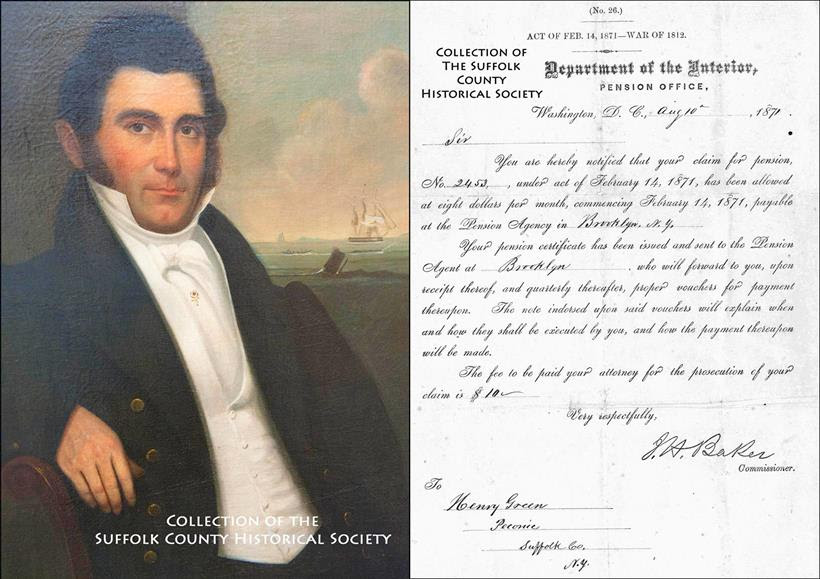
Captain Henry Green, 1824, oil on canvas, by Hubbard L. Fordham of Sag Harbor (from the Collection of the SuffolkCounty Historical Society Museum). Right: War of 1812 Pension Certificate No. 2453, issued August 10, 1871, by the Pension Office of the U.S. Dept. of the Interior to Henry Green of Peconic (from the Collection of the Suffolk County HistoricalSociety Library Archives). Images © Suffolk County HistoricalSociety. All rights reserved.
Born in Sag Harbor in 1794, Henry Green served as whaling captain of numerous ships during his twenty-six-year tenure in that occupation. He married Roxanna Stewart Fordham of Sag Harbor, and in 1851 he moved with his large family to a home on Main Road, Peconic, opposite Skunk Lane. The home still stands today, and was among a row of Main Road residences occupied by retired whaling captains, an area that was known as Blubber Row or Blubberville.
On August 26, 1839, the Spanish schooner Amistad dropped anchor off Montauk, and as sea captains Henry Green and Pelatiah Fordham were shooting birds in the area, they came across the African shore party. The Africans told the men, through sign language, that there were two great chests of gold aboard that they would give anyone who supplied them with provisions and helped them get back to Africa. (For more on the Amistad story, see the citation below.)
During the War of 1812, Henry Green served as Private to Captain David Hedges’ Co. Militia. Upon his retirement, Green collected an $8 per month pension from the Dept. of the Interior. He died in 1873 and is buried at Oakland Cemetery in Sag Harbor.
Suggested Reading: “The Amistad Case,” by Douglas Linder, University of Missouri School of Law, 2007, available at: https://ssrn.com/abstract=

Photo of the Week
———— October 18, 2021 ————
FROM THE SCHS LIBRARY ARCHIVES
“How shall we know it is us without our past?”
– John Steinbeck
~~~~~~~~~~~~~~~~~~~~~
Hudson Cultivator, Riverhead, c. 1887
by Wendy Polhemus-Annibell, Head Librarian
********

Small-Scale Model of the Hudson Cultivator, Riverhead, c. 1887. (From the Collection of the Suffolk County Historical Society Museum. Image copyright © Suffolk County Historical Society. All rights reserved.)
The inventor of this unusual but useful contribution to Suffolk County agriculture was Riverhead resident Samuel Terry Hudson, born in 1843 on the Riverhead farm where his grandfather Daniel Hudson had lived. Samuel Terry Hudson was the only child of Samuel and Elizabeth (Terry) Hudson. He attended the academies of Northville and Franklinville, and in 1861 he married Mary, the daughter of J. Edward Wells of Riverhead.
Samuel Terry Hudson designed several farm machines and implements. His first invention was a machine for stripping leaves from sorgum. By 1887 Hudson had built a factory in Riverhead called the Riverhead Agricultural Works, where he manufactured potato diggers, pot sprayers, harrows, weeders, and riding cultivators–all designed specifically for Suffolk County’s agricultural conditions. The Hudson Cultivator, also known as a riding or bicycle cultivator, attracted the most attention nationally and was sold to farmers across the United States. It was primarily manufactured by others on a royalty basis.
Hudson was a charter member of the Agricultural Society in Riverhead, and a stockholder in the company that started Point o’ Woods, a Fire Island summer resort community where Hudson spent part of many summers in a private cottage.
********************

Photo of the Week
—————— Monday, October 11, 2021 ——————
FROM THE SCHS LIBRARY ARCHIVES
“How shall we know it is us without our past?”
– John Steinbeck
LIRR Experimental Farm # 1: “Peace and Plenty”
by Wendy Polhemus-Annibell, Head Librarian
********
Edith Fullerton Among the Tomato Harvest, Wading River, c. 1900. Photograph by Hal B. Fullerton. Hand-colored. (From the Harry T. Tuthill Fullerton Collection of the Suffolk County Historical Society Library Archives. Copyright © Suffolk County Historical Society. All rights reserved. ED: to see Fullerton photo, please visit SCHS website.)
Edith Loring Fullerton, photographer Hal B. Fullerton’s spouse, is shown here at the Wading River LIRR Experimental Farm cleaning tomatoes by the railroad tracks that extended to the area in the early twentieth century. In the hand-colored print reproduced from a glass-plate negative, one can see that the tomatoes themselves share the size and shape of the heirloom tomato known today as ‘Brandywine.’ In 1905, Edith wrote about growing tomatoes and other gardening topics in her book How to Make a Vegetable Garden:
The tomato…is a native of a warm climate, that of South America, and in the old days it was considered a curious rarity in North America. Its name was then the ‘Love Apple,’ for it was so often used in courtship as to be highly prized by the damsel who received it from her preferred lover; and it was also much in demand as a mantel ornament. Great was the dismay among our grandmothers when the younger generation began eating the fruit, for it was considered distinctly poisonous. The original tomato was very small, not much larger than a cherry, and it has been used in our country as an edible only during the last 50 years…. We always have two kinds [of tomatoes] in our garden, large red and yellow egg.
On 10 acres of land along the LIRR tracks in Wading River, Edith and her husband set up the LIRR Experimental Farm #1, nicknamed “Peace and Plenty.” Their success at Wading River led to LIRR Experimental Farm #2, “Prosperity Farm,” in Medford, where 80 acres were cleared and planted. Over a period of many years during the early twentieth century, both farms were an enormous success, as the Fullertons grew nearly a thousand varieties of produce, many of them prize-winners at county and state fairs.
Suggested Reading: How to Make a Vegetable Garden: A Practical and Suggestive Manual for the Home Garden, by Edith Loring Fullerton (Doubleday, 1905).
~~~~~~~~~~~~~~~~~~
~~~~~~~~~~~~ SEPTEMBER 2021 ~~~~~~~~~~~~


Photo of the Week
—————— September 27 , 2021 ——————
FROM THE SCHS LIBRARY ARCHIVES
“How shall we know it is us without our past?”
– John Steinbeck
Daughters of the Revolution, 1891 – 1983
by Wendy Polhemus-Annibell, Head Librarian
————————-
National Society of the Daughters of the Revolution, 1891-1983. (Image from the Collection of the Suffolk County HistoricalSociety Library Archives, the official D of R repository.)
The National Society of the Daughters of the Revolution (known as the “D of R”) was organized in 1891 after a difference of opinion within the Daughters of the American Revolution (DAR) arose over membership qualifications. The D of R was incorporated under the laws of the State of New York as an organization national in its work and purpose. The objectives of the society were stated in its constitution:
“To perpetuate the patriotic spirit of the men and women who achieved American Independence; to commemorate prominent events connected with the War of the Revolution; to collect, publish, and preserve the rolls, records, and historic documents relating to that period; to encourage the study of the country’s history; and to promote sentiments of friendship and common interest among the members of the Society.”
A woman was eligible for D of R membership if she was above the age of eighteen and was descended from an ancestor who “assisted in establishing American Independence during the War of the Revolution, as a military or naval officer, a soldier or a sailor, an official in the service of any of the thirteen original Colonies or of the United Colonies or States or of Vermont; a member of a committee of Correspondence or of Public Safety, or a recognized patriot who rendered material service in the cause of American Independence.”
When the National Society of the Daughters of the Revolution disbanded in 1983, the Suffolk County Historical Society Library & Archives became the official repository of the D of R’s national member application records and other materials. Though the collection has not been digitized, an invaluable electronic finding aid is available on the website of the German Genealogy Group (www.germangenealogygroup.com)
********************

Photo of the Week
—————— September 13, 2021 ——————
FROM THE SCHS LIBRARY ARCHIVES
“How shall we know it is us without our past?”
– John Steinbeck
Roberto Bessin’s The 9/11 Morning Call, Greenport
by Wendy Polhemus-Annibell, Head Librarian

The 9/11 Morning Call Sculpture, Greenport, 2002. (Photo courtesy of Wendy Polhemus-Annibell.)
While some memories may fade with the passage of time, the terrorist attacks of September 11, 2001 remain strongly with us as we pause to remember the tragic and heroic losses of that day in New York, at the Pentagon, and in a Shanksville, Pennsylvania field.
This Morning Call art sculpture memorializes Long Island’s involvement in the events of 9/11 that took place twenty years ago today. Crafted by artist Roberto Bessin, the sculpture was installed on the docks at Greenport in 2002. The osprey stands on beams recovered from the World Trade Center site after the Sept. 11, 2001 attacks. Made of bronze and weighing over 5,000 pounds, Morning Call was moved to a park in Peconic in 2011. Here the sculpture is shown at Greenport in a photograph by the author.
********************
~~~~~~~~~~~~ AUGUST 2021 ~~~~~~~~~~~~

Photo of the Week
—————— Sunday, August 30, 2021 ——————
FROM THE SCHS LIBRARY ARCHIVES
“How shall we know it is us without our past?”
– John Steinbeck
————————-
Women’s Equality Day, August 26th
by Wendy Polhemus-Annibell, Head Librarian
********
 Rosalie Gardiner Jones on the Long Island Suffrage Wagon Advocating “Votes for Tomorrow,” c. 1913. (Image from the Collection of the Suffolk County Historical Society Library Archives. Copyright © Suffolk County Historical Society. All rights reserved.)
Rosalie Gardiner Jones on the Long Island Suffrage Wagon Advocating “Votes for Tomorrow,” c. 1913. (Image from the Collection of the Suffolk County Historical Society Library Archives. Copyright © Suffolk County Historical Society. All rights reserved.)
Last week on August 26 was Women’s Equality Day. In 1973, at the behest of Rep. Bella Abzug from New York, the U.S. Congress designated August 26 as “Women’s Equality Day.” The date was selected to commemorate the August 26, 1920 certification of the 19th Amendment to the U.S. Constitution, granting women the right to vote. This was the culmination of a massive, peaceful civil rights movement by women that had its formal beginnings in 1848 at the world’s first women’s rights convention, in Seneca Falls, New York. The observance of Women’s Equality Day not only commemorates the passage of the 19th Amendment, but also calls attention to women’s continuing efforts toward full equality.
Rosalie Gardiner Jones (1883-1978) of Cold Spring Harbor became prominent in the suffrage struggle, teaming up with Elizabeth Freeman of Kings Park and other Long Island suffragists to travel across Suffolk County, through Shoreham, Port Jefferson, Smithtown, and Northport, selling copies of their newspaper, Woman Voter Daily, suffrage literature, and buttons to raise funds for the suffrage battle. Jones and her “pilgrims” (as they were called) set out for Washington, D.C., in 1913, where a large suffrage parade was planned for March 3, the day before the inauguration of the new president, Woodrow Wilson. They carried a banner that read: “Criminals and the insane can’t vote, neither can I, what about it?” Over five thousand women marched down Pennsylvania Avenue on that day to the cheers of onlookers.
*****************************
Photo of the Week
—————— Sunday, August 23, 2021 ——————
FROM THE SCHS LIBRARY ARCHIVES
“How shall we know it is us without our past?”
– John Steinbeck
————————-
Old Field Lighthouse, 1933
by Wendy Polhemus-Annibell, Head Librarian
********

Old Field Lighthouse, 1933. (Image from the Brookhaven Pictorial Collection of the Suffolk County Historical Society Library Archives. Copyright © Suffolk County Historical Society. All rights reserved.)
In 1822-1823, the U.S. Congress provided $4,000 for the construction of a lighthouse at Old Field Point near the entrance to Port Jefferson Harbor. The land was purchased from Samuel Thompson for $400. Construction of the 30-foot octagonal stone tower and separate 1-1/2-storey lightkeeper’s house was completed in 1824. The lighthouse had nine whale oil lamps that were arranged in a lantern and magnified with parabolic reflectors. Though the original lighthouse was rebuilt in the 1860s, the keeper’s house remains. Shortly after the Civil War, a new, 67-foot-tall lighthouse was built to accommodate the increased shipping traffic on Long Island Sound. Construction of this currently existing lighthouse was completed in 1869. Its Victorian-Gothic Revival style is similar to that of the Plum Island Lighthouse. Kerosene was first used to power the lamp, but today the electric unit flashes alternating red and green and has a range of 30 miles.
The Old Field Lighthouse was deactivated in 1933 and the property was conveyed to the Village of Old Field in 1935 for public-park purposes. After the bombing of Pearl Harbor in 1941, however, the government seized the station, along with Southold’s Horton Point Lighthouse, for purposes of national defense. Horton Point was manned by aircraft spotters, while a small Coast Guard contingent occupied Old Field Light. After the war, both lighthouses were returned to their respective communities.
According to “Lighthouses of the United States,” Suffolk County has more lighthouses than any other county in the United States, and Southold Town has more lighthouses than any other town in the county. You can view the long list of Long Island’s lighthouses at this link: Long Island’s Lights.
~~~~~~~~~~~~~~~~~~~~~~~~~~~~~~
SUGGESTED READINGS
- Harlan Hamilton, Lights and Legends: A Historical Guide to Lighthouses of Long Island Sound, Fishers Island Sound, and Block Island Sound (2006).
- “Lighthouses of the United States: Long Island, New York,” https://www.ibiblio.org/
lighthouse/nyli.htm
*****************************
Photo of the Week
—————— Sunday, August 16, 2021 ——————
FROM THE SCHS LIBRARY ARCHIVES
“How shall we know it is us without our past?”
– John Steinbeck
————————-
Battery Gunning, Patchogue, 1900
by Wendy Polhemus-Annibell, Head Librarian
********
Battery Gunning, Patchogue, Great South Bay, 1900, by Hal B. Fullerton. (Image from the Harry T. Tuthill Fullerton Collection of the Suffolk County Historical Society Library Archives [149.7.33]. Copyright © Suffolk County Historical Society. All rights reserved). [To view Fullerton photograph, please visit www.suffolkcountyhistoricalsociety.org]
In 1850, Long Island was a gunner’s and a duck hunter’s paradise. Thousands upon thousands of migratory waterfowl sought refuge on the island each spring and fall between their Arctic breeding grounds and southern wintering quarters. Many local hunters supplemented their income by market gunning because hunting ducks for NYC restaurants was a way to survive. Sportsmen and market gunners enjoyed profitable hunting with few restrictions until the waterfowl diminished. Then, in 1918, the International Migratory Bird Act ended commercial gunning and set limits for hunters.
In the nineteenth century, however, old-time duck hunting was a popular sport, and many hunting clubs sprung up across the island: the Pelican Club at Montauk’s Gin Beach, the Long Island Shooting Club, the Wyandanch Club in Smithtown, the Suffolk Club at South Haven, the Flanders Club, and the Southside Sportmen’s Club in West Sayville, among many others. The first such club may have been the Suffolk Club, located on the Carmans River in old Brookhaven. It was there that Daniel Webster rented a piece of land in 1823 and invited his friends to fish and hunt–including Martin Van Buren, who in 1837 would become our eighth U.S. president. The property would eventually become Suffolk County’s South Haven Park. In fact, many public parks resulted from the county’s acquisition of some of the gun clubs’ lands. In addition, Long Island shorebird and duck decoys are a legacy of the gunning era. Today, these hand-carved decoys are valued as both art and historical objects.
Suggested Reading: Gunners Paradise: Wildfowling and Decoys on Long Island, by E. Jane Townsend, 1979.
********
*****************************
Photo of the Week
—————— Sunday, August 9, 2021 ——————
FROM THE SCHS LIBRARY ARCHIVES
“How shall we know it is us without our past?”
– John Steinbeck
————————-
Temple Mishcan Israel, Sag Harbor, c. 1900
by Wendy Polhemus-Annibell, Head Librarian
********

Temple Mishcan Israel, Sag Harbor, c. 1900: First Synagogue on Eastern Long Island.
Image courtesy Eileen Moskowitz, Temple Adas Israel.
As eastern Long Island’s oldest synagogue, Temple Adas Israel was founded as Congregation Mishkan Israel in 1893. The temple purchased land in 1896, and the building was completed in circa 1900. The Brooklyn Daily Eagle attributed the creation of the new congregation to the establishment of Fahy’s watchcase factory, which had drawn a large number of Russian and Polish-Jewish workers to Sag Harbor. Formal dedication ceremonies were held October 28, 1900.
The exterior of the temple was painted white; it had a peaked roof and two plain white pillars that stood on either side of the entrance door. Inside, in European tradition, there were two altars: one in the center of the synagogue where the rabbi and cantor read the Torah scroll, and the other at the East wall facing Jerusalem, containing the Ark, Eternal Light, and Tablets of the Commandments. Seating capacity was 100. Since the temple was originally Orthodox––and women were not permitted to worship with men––a Ladies Gallery, with its own exterior entrance, was built with additional seating for 60. The basement contained a mikvah, a baptismal font used by Orthodox Jewish women for purposes of ritual cleanliness, as well as in the ceremony of conversion of a Gentile to Judaism. There was also an apartment for a janitor, which was later used by resident and itinerant rabbis.
Legend has it that Sag Harbor’s Temple Mishcan Israel was given its first Torah by Theodore Roosevelt. According to the story, Roosevelt acquired the Torah in 1898 when he returned to the United States with twelve hundred Rough Riders he had led in the charge up San Juan Hill during the Spanish American War. When three of his men contracted yellow fever, Roosevelt returned to American shores via Montauk. The brigade was quarantined for a month to ensure no one else caught the contagious disease. During their stay in Montauk the men held worship services, including Shabbat services for the Jewish soldiers. A Torah was procured for this purpose. When the brigade left, after the quarantine period, Roosevelt donated the Torah to the nearest synagogue: Temple Mishcan Israel in Sag Harbor.
INFO. SOURCE: Beth Moskowitz, “Temple Adas Israel, Sag Harbor, NY: Our History.”
*****************************
Photo of the Week
—————— Sunday, July 26, 2021 ——————
FROM THE SCHS LIBRARY ARCHIVES
“How shall we know it is us without our past?”
– John Steinbeck
————————-
Seals of Suffolk County’s Ten Towns
by Wendy Polhemus-Annibell, Head Librarian
********
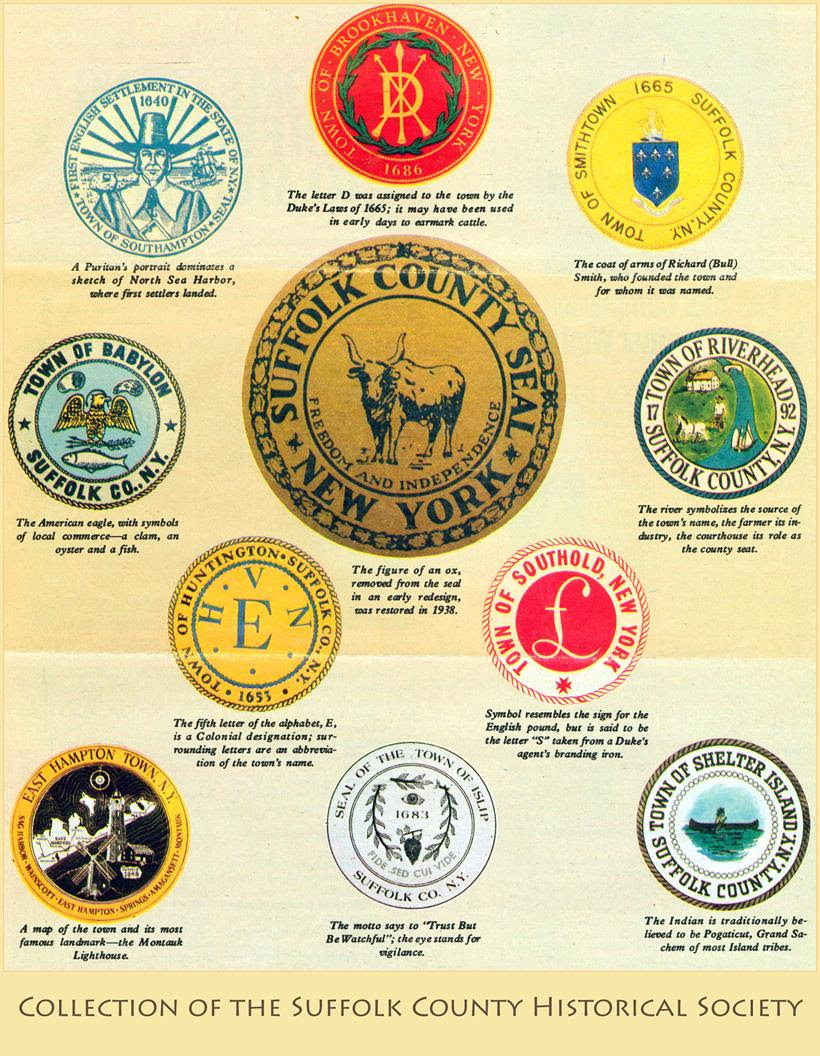
Suffolk County, created in 1683, today has ten familiar towns: Babylon, Brookhaven, East Hampton, Huntington, Islip, Riverhead, Shelter Island, Smithtown, Southampton, and Southold, each with its own governing board.
In 1683, however, according to Laws of the Colony of New York (1894), an act to divide the New York colony into counties, which passed on November 1, 1683, stated: “The County of Suffolk to contain the several towns of Huntington, Smithfield [Smithtown], Brookhaven, Southampton, Southold, Easthampton to Montauk Point, Shelter Island, the Isle of Wight [Gardiners Island], Fishers Island, and Plumb Island….” Over time changes occurred. Riverhead, for example, once a part of Southold town, became a town of its own in 1792. Similary, Babylon, known as Huntington South, was a part of the town of Huntington until 1872, when it became a town with its own governing unit.
The towns of Suffolk County were all settled by English immigrants. In fact, Suffolk County is the oldest county of purely English settlements within New York state.
~~~~~~~~~~~~~~~~~~~~~
Photo of the Week
—————— Sunday, July 19, 2021 ——————
FROM THE SCHS LIBRARY ARCHIVES
“How shall we know it is us without our past?”
– John Steinbeck
————————-
Lake-By-The-Sea, Camp Dunes, Peconic, c. 1920s
by Wendy Polhemus-Annibell, Head Librarian
********
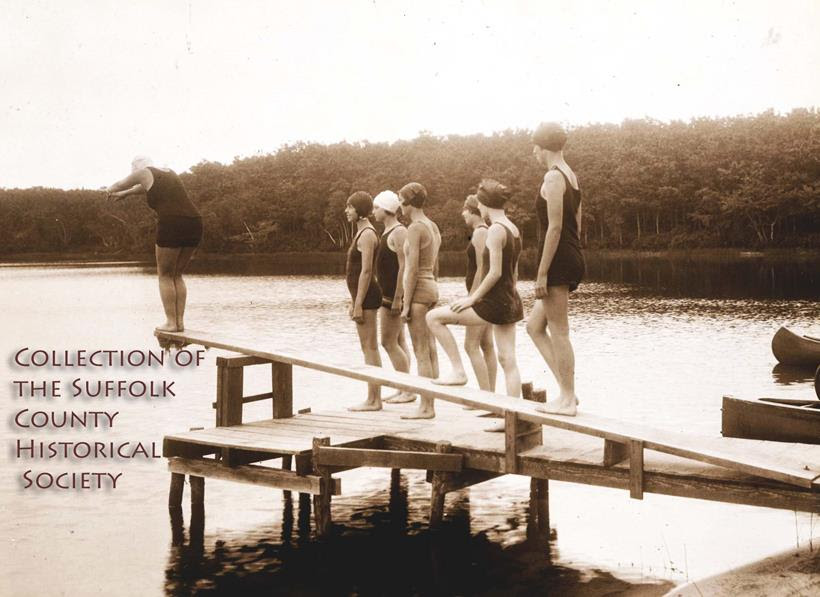
Campgoers at Lake-by-the-Sea, Camp Dunes, Peconic, c. 1920s. (From the Camp Dunes Collection of the Suffolk County Historical Society Library Archives. Image copyright © Suffolk County Historical Society. All rights reserved.)
Camp Dunes was an all-girls summer camp located on over 26 acres on the Long Island Sound and included access to Great Pond Lake. The Peconic camp was owned and operated by Luvia Willard, M.D., of Jamaica, NY (who also owned a home on Great Pond Lake); Marian Wood of Philadelphia was co-director. The rate was $150 for 8 weeks of summer camp for girls aged 14 to 18, according to a 1924 ad in the Long Island Daily Press. Food for the camp was purchased from neighboring farms and village markets, and the female campgoers engaged in various activities: swimming, boating, play-acting, and the like.
“The maritime climate together with the unusual amount of sunshine peculiar to this locality make for an unusually healthful environment. The Geodetic Survey shows that the region around Peconic, Long Island, averages to the year one hundred days more sunshine than New York City,” notes a Camp Dunes brochure in our collection, which also features this poem:
Far from the city’s maddening din,
Out where the Sunrise Trails begin,
Where the toes of the dunes are kissed by the sea,
Is a camp that seems just made for me.
Where the birches dress in their silvery white,
And gnarled oaks squirm in sheer delight,
Where tall pines frame a sapphire sea,
Is a camp that seems just made for me.
There are hill camps, and lake camps, and camps by the sea,
But there’s only one camp by the lake and the sea.
*****************
Photo of the Week
—————— Sunday, July 12, 2021 ——————
FROM THE SCHS LIBRARY ARCHIVES
“How shall we know it is us without our past?”
– John Steinbeck
————————-
Map of Sound Beach, c. 1930
by Wendy Polhemus-Annibell, Head Librarian
********

Daily Mirror Map of Sound Beach, c. 1930. (From the Collection of the Suffolk County Historical Society Library Archives. Image copyright © Suffolk County Historical Society. All rights reserved.)
Sound Beach came about in the late 1920s as a result of a newspaper’s strategy to boost its circulation numbers. The NYC-based Daily Mirror purchased over a thousand acres in Sound Beach in 1928, and the following year began advertising 20 x 100-foot lots for $89.50. The only requirements were a $12.50 down payment, a monthly payment of $3.50 until the loan was paid off, and maintaining a one-year renewable subscription to the newspaper. Buyers showed up and purchased the 2,000-square-foot lots by the Sound; some pitched tents and erected outhouses on their newly purchased lots until they were able to build their summer cottages. They got by without electricity or running water at first. After World War II, most of these original Sound Beach summer cottages were converted to year-round homes.
——————
Photo of the Week
—————— Sunday, July 4, 2021 ——————
FROM THE SCHS LIBRARY ARCHIVES
“How shall we know it is us without our past?”
– John Steinbeck
————————-
July 4th Holiday Postcard
by Wendy Polhemus-Annibell, Head Librarian
********

July 4th Holiday Postcard. (From the Collection of the Suffolk County Historical Society Library Archives. Image Copyright © Suffolk County Historical Society. All rights reserved.)
On July 4, 1776, the thirteen colonies claimed their independence from England, an event that eventually led to the formation of the United States of America. Each year on the Fourth of July, also known as Independence Day, Americans celebrate this historic event.
The Staff and Board of the Suffolk County Historical Society would like to wish all of our readers, members, and other supporters a happy and safe holiday celebration.
——————
Photo of the Week
——— Monday, June 28, 2021 ———
FROM THE SCHS LIBRARY ARCHIVES
“How shall we know it is us without our past?”
– John Steinbeck
——————-
SUFFOLK COUNTY FAIR
by Wendy Polhemus-Annibell, Head Librarian
********
Suffolk County Fair Exhibit of the Central Islip State Hospital at the Riverhead Fair Grounds, 1907, by Hal B. Fullerton. (Image from Harry T. Tuthill Fullerton Collection of the Suffolk County Historical Society Library Archives. Copyright (c) Suffolk County Historical Society. All rights reserved.) [ED: to view the Fullerton photograph, please visit www.schs-museum.org]
Organized by the Suffolk County Agricultural Society, the Suffolk County Fair took place for nearly a hundred years–from the 1840s through most of the 1930s. The annual fair was originally held at several locations around Suffolk County. In 1867, a group of Riverhead citizens purchased twenty acres of vacant land west of the Riverhead Cemetery and donated it to the agricultural society so the fair could be held annually at a permanent location.
The first fair at the new site was held in 1868, and from that point on the Riverhead Fair Grounds became the locale of the annual Suffolk County Fair–as well as the site of numerous other popular events in Suffolk County’s history. Babe Ruth once played a baseball game at the venue, Teddy Roosevelt campaigned for New York State governor there, and harness races were held on the track. The Riverhead Fair Grounds continued to host the annual county fair until the property was sold in 1936 to the Riverhead School District.
****************************************
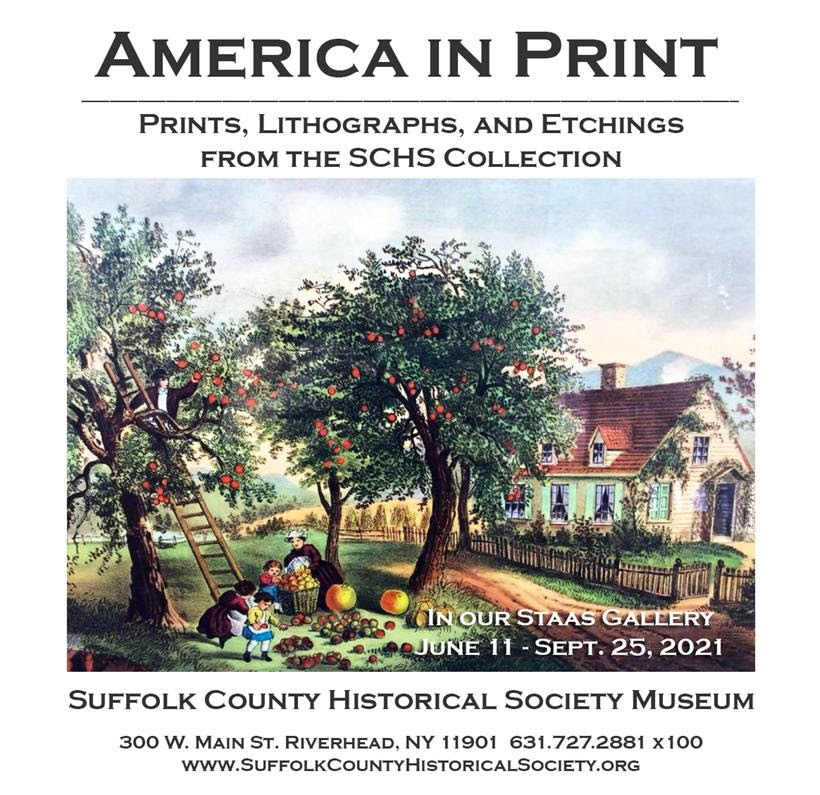
AMERICA IN PRINT Now in our Staas Gallery!
Before the 1800s, art was largely reserved for the wealthy, but with the invention of lithography in 1796 – and particularly color lithography in 1837 – printers were able to mass-produce beautiful color prints that were cheap enough for anyone to buy. Suddenly, art was available to all–from such notable printers as Louis Prang, Napoleon Sarony, and Currier and Ives. Featuring themes of nineteenth-century life in landscapes, cityscapes, seascapes, and more, as well as rare examples of “lithographic Long Island,” this exhibit captures the evolution of an American art form.
Our newly renovated Grand Staas Gallery includes a new ceiling and paint, upgraded climate control, and “green energy-efficiency” lighting, earning us the recognition of a PSEG “Certified Green Energy Business”!
============================================
Photo of the Week
———— Week of June 21, 2021 ————
FROM THE SCHS LIBRARY ARCHIVES
“How shall we know it is us without our past?”
– John Steinbeck
—————————-
The American Anti-Slavery Almanac, 1840
by Wendy Polhemus-Annibell, Head Librarian
********

The American Anti-Slavery Almanac for 1840. (Image collage features primary source documents in the Collection of the Suffolk County Historical Society Library Archives Copyright (c) Suffolk County Historical Society. All rights reserved.)
Slavery was officially abolished in New York State in 1827, less than two hundred years ago, and this week President Joe Biden signed into a law a bill designating June 19–or Juneteenth–a federal holiday in recognition of the end of slavery in the United States.
Juneteenth National Independence Day became the 12th legal federal holiday, and the first new one since Martin Luther King Jr. Day was signed into law in 1983 by then-President Ronald Reagan.
On Long Island in 1698, some 1,100 slaves called “bondsman” resided here; 10 percent of the population of Southampton was enslaved at this time. In 1749, some 3,400 slaves resided on Long Island; and in 1775, on the eve of the American Revolution, there were 5,000 enslaved people. Manumissions (the freeing of slaves) increased during and after the Revolution. In 1788, a manumission law was enacted that provided for freeing slaves but protected those who were elderly or ill from being freed without adequate provisions for their care. New York declared that all children born of slaves after July 4, 1799, were free, though the owners could retain the male child’s service until age twenty-eight and the female’s until age twenty-five. However, the slaveowner could also elect to abandon his claim to the child’s service and pass the responsibility for supporting the child to the state.
A state law enacted in 1817 provided that by 1827 all slaves in New York would be considered free.
———————
SUGGESTED READING: Grania Bolton Marcus, Discovering the African-American Experience in Suffolk County, 1620-1860 (Cold Spring Harbor, NY: Society for the Preservation of Long Island Antiquities, 1995).
************************
Photo of the Week
———— Week of June 14, 2021 ————
FROM THE SCHS LIBRARY ARCHIVES
“How shall we know it is us without our past?”
— John Steinbeck
~~~~~~~~~~~~~~~~~~
Summertime, 1916 / Autochrome Glass Plate
by Wendy Polhemus-Annibell, Head Librarian
————
Eleanor Fullerton at Blooming Roses on Arbors, LIRR Experimental Farm, Medford, circa June 1916, by Hal B. Fullerton [Autochrome glass plate]. (Image from Harry T. Tuthill Fullerton Collection of the Suffolk County Historical Society Library Archives. Copyright (c) Suffolk County Historical Society. All rights reserved.) [Ed — To view the Fullerton photograph, please visit the Suffolk County Historical Society’s website @ www.suffolkcountyhistoricalsociety.org.]
As John Steinbeck once said, “What good is the warmth of summer, without the cold of winter to give it sweetness?” The first day of summer is only nine days away, and this week’s SCHS photo brings us back in full “Autochrome” color to summertime in Medford in June of 1916. We can pinpoint the month because the rambling roses are in peak bloom in the image.
Digitally restored from the original Autochrome glass plate, this image features photographer Hal Fullerton’s daughter Eleanor standing by a series of rose arbors made from tree limbs. Autochrome Lumière, an early color photography process created by the Lumière brothers in France in the early 1900s, was the primary color photography process in use before the advent of color film in the 1930s. The Autochrome process used a glass plate covered with grains of potato starch dyed to act as primary-color filters and black dust that blocked all unfiltered light. It was then coated with a thin film of panchromatic emulsion, resulting in a positive color transparency.
*****************************
Photo of the Week
———— Week of June 6, 2021 ————
FROM THE SCHS LIBRARY ARCHIVES
“How shall we know it is us without our past?”
– John Steinbeck
Old Oyster Packing House & Dock, New Suffolk
by Wendy Polhemus-Annibell, Head Librarian
********
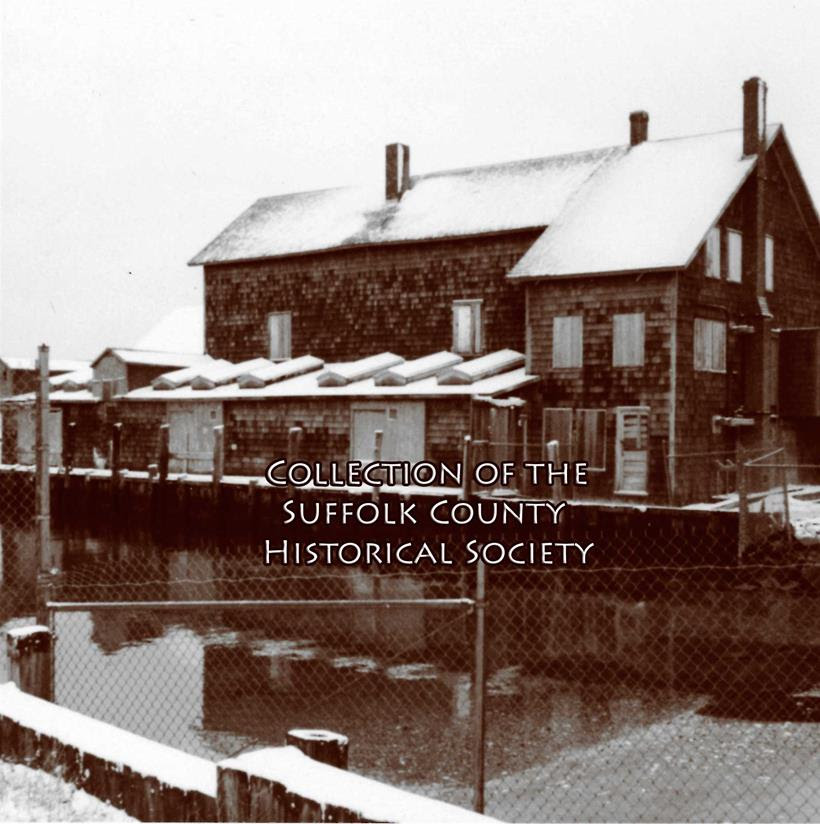
Old Oyster Packing House and Dock, New Suffolk. (From the Collection of the Suffolk County Historical Society Library Archives. Image Copyright © Suffolk County Historical Society. All rights reserved.)
The oyster packing house burned down in 1980, but before that time it was home to the Standard Oyster Company at New Suffolk, a subsidiary of the Andrew Radel Oyster Company, planters and wholesale shippers of Robbins Island Oysters.
According to an informational brochure published by the company in 1935 (also within our collection), in just a few hours a crew of fourteen men on a steamboat was capable of catching and unloading 3,000 bushels of oysters a day from the Great Peconic Bay. The oysters were harvested with a dredge or mesh basket dropped overboard and dragged over the oyster beds for 100 yards to catch the oysters. After the dredge was emptied onto the boat, it would be lowered for another haul into the deep salty oyster beds of the bay. The oysters were then taken to the packing house, cleaned, assorted for size, and packed into barrels for same-day shipping. “That’s one reason they taste so good!”
Suggested Reading: Robbins Island Oysters, New Suffolk, Long Island, by Standard Oyster Company, Sole Producers of Robbins Island Oysters, 1935.
*****************
Photo of the Week
———- May 31, 2021 ———-
FROM THE SCHS LIBRARY ARCHIVES
“How shall we know it is us without our past?”
– John Steinbeck
******************
Fort Terry, Plum Island / ‘Soldiers Memorial’, 1902
by Wendy Polhemus-Annibell, Head Librarian
********
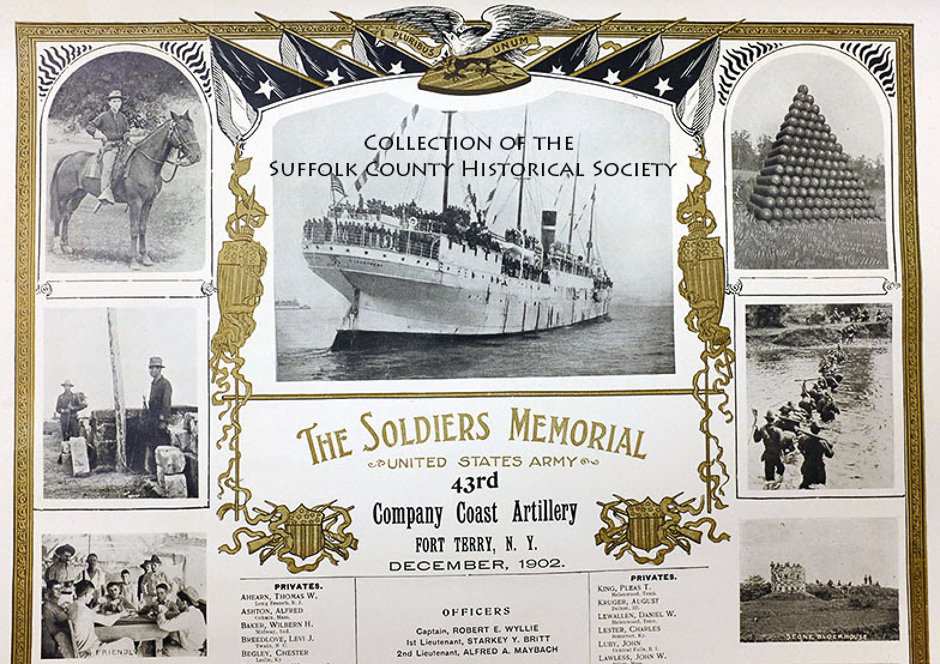
Fort Terry: “The Soldiers Memorial” Poster (upper half), 1902.(From the Collection of the Suffolk County Historical Society Library Archives. Copyright © Suffolk County Historical Society. All rights reserved.)
Located on Plum Island, in the town of Southold, Fort Terry was a heavily armed coastal defense fortification established in 1897 and used from the Spanish American War period through the end of World War II. It was decommissioned in 1948. Named after Alfred Howe Terry (1827-1890) from Connecticut, a Union general in the Civil War, Fort Terry was one of several forts that the U.S. government commissioned along the Long Island Sound to defend against an invading force. By 1914 the fort had eleven gun batteries, including mortar, disappearing, and pedestal batteries, as well as facilities to control an underwater minefield.
—————————
Photo of the Week
———- May 24, 2021 ———-
FROM THE SCHS LIBRARY ARCHIVES
“How shall we know it is us without our past?”
– John Steinbeck
Land Grant for the Manor of St. George, 1697
by Wendy Polhemus-Annibell, Head Librarian
********

Land Grant for the Manor of St. George, Shirley, NY, 1697. Ink on vellum, 63 x 46 cm. (From the Collection of the Suffolk County Historical Society Library Archives. Copyright © Suffolk County Historical Society. All rights reserved.)
This patent for the Manor of St. George was granted by Governor Fletcher of New York to Colonel William “Tangier” Smith in 1697. It is one of the best-preserved seventeenth-century documents in our library archives.
The Manor of St. George is an important chapter in the history of Long Island, the United States, and the colonies that preceded them. Colonel William Smith had filed application with the governor, formally petitioning that his estate be erected into a manor to be known as the Manor of St. George. In those days in New York’s rural districts, many great manorial estates came into being. The proprietor was known as the Lord of the Manor and that title denoted an ownership of land invested with ancient and extensive priviliges.
For more than three centuries, the Manor of St. George was occupied by the Col. William Tangier Smith family. The Manor was also the scene of a famous revolutionary war battle: After the British captured Long Island in the War of 1776, the Manor of St. George became Fort St. George, a British-held bastion and supply base for land and sea forces, because of its proximity to the inlet that then existed in the barrier beach opposite Mastic, and because the British coveted the woods in its forests. Fort St. George was short-lived in British hands; in 1780, it was recaptured in a surprise 4 a.m. attack by American forces led by Col. Benjamin Tallmadge.
*****************
Photo of the Week
———- May 17, 2021 ———-
FROM THE SCHS LIBRARY ARCHIVES
“How shall we know it is us without our past?”
– John Steinbeck
~~~~~~~~~~~~~~~~~~~
Huntington, Founded 1653
by Wendy Polhemus-Annibell, Head Librarian
********
Nathan Hale Beach, Huntington, 1899, by Hal B. Fullerton.(Image from the Harry T. Tuthill Fullerton Collection of the Suffolk County Historical Society Library Archives. Copyright © Suffolk County Historical Society. All rights reserved.) [To view the Fullerton photo, please visit the SCHS website.]
Huntington was founded in 1653 by three men from Oyster Bay who purchased a parcel of land from the Matinecock tribe. This parcel, which has since become known as the “First Purchase,” included land bordered by Cold Spring Harbor on the west, Northport Harbor on the east, what is now known as Old Country Road to the south, and Long Island Sound to the north. The men immediately turned the land over to the white settlers who had already been living there. From this initial settlement, Huntington grew over subsequent years to include all of the land presently comprising the modern Towns of Huntington and Babylon. It wasn’t until 1872 that the southern part of the town was formally separated to create Babylon Town.
Because colonial Huntington was populated largely by English settlers, unlike the rest of the New Amsterdam colony, the town voted in 1660 to become part of the Connecticut colony rather than remain under the authority of New Amsterdam. When the British gained control of New Amsterdam in 1664 (renaming it “New York”), Huntington was formally restored to the jurisdiction of New York. Following the Battle of Long Island during the Revolutionary War, British troops used Huntington as their headquarters and remained encamped there until the end of the war.
When President George Washington visited Huntington in 1790, the town had 2,000 residents. Most lived in Huntington hamlet, with farmhouses scattered in the rest of the town. By the early 1800s, the town’s population had grown to over 4,000. The arrival of the Long Island Railroad in 1867 transformed the economy of Huntington from primarily agriculture and shipping (based on its well-protected harbor) to tourism and commuting. The end of World War II brought about an explosive growth of population in Huntington, where farms and resorts gave way to residential homes and businesses.
*****************
******************
Photo of the Week
———- May 10, 2021 ———-
FROM THE SCHS LIBRARY ARCHIVES
“How shall we know it is us without our past?”
– John Steinbeck
~~~~~~~~~~~~~~~~~~~
Chace Map of Shelter Island, 1858
by Wendy Polhemus-Annibell, Head Librarian
********

Shelter Island on the Chace Map of Suffolk County, 1858.(Image from the Collection of the Suffolk County Historical Society. Copyright Suffolk County Historical Society. All rights reserved.)
Early in the seventeenth century the island known as Manhansack-aha-quash-awamock – “an island sheltered by islands” – was the home of the Manhanset Indians. The first European to visit the island was James Farrett, who came in 1638 as an agent for Sir William Alexander, Earl of Sterling, who had received grants of land from King James I of England. Farrett chose Shelter Island as his reward for his services to the Earl, which then became known as Mr. Farrett’s Island.
In 1641 Farrett sold his island to Stephen Goodyear of New Haven, and for the next ten years the island was known as Mr. Goodyear’s Island. Then, in 1651, Goodyear sold the island to four merchants active in the Barbados sugar trade: Thomas Middleton, Thomas Rouse, Constant Sylvester, and Nathaniel Sylvester. We know from a deed dated 1652 that the island’s name had by that time been changed to Shelter Island.
By 1673 Nathaniel Sylvester became the sole proprietor of Shelter Island, his partners having died or had their estates confiscated for political reasons. When Nathaniel died in 1680, by his will, Shelter Island was bequeathed to his five sons in equal parts, but by 1695 Giles Sylvester, the eldest son, owned four-fifths of the island after the deaths of his brothers. Giles sold one-quarter of the island, including a section known as Sachem’s Neck, to William Nicoll. Thus were introduced the early European families of Shelter Island, many of whom went on to assume prominent roles in the island’s affairs.
Suggested Readings: The History of Shelter Island, by Ralph G. Duvall, 1932; and An Island Sheltered, by Priscilla Dunhill, 2002.
~~~~~~~~~~~~~~~~~~~~~~
Photo of the Week
———- May 3, 2021 ———-
FROM THE SCHS LIBRARY ARCHIVES
“How shall we know it is us without our past?”
– John Steinbeck
******************
From Farm to Market: Long Island Home Hamper, 1908
by Wendy Polhemus-Annibell, Head Librarian
———————————-
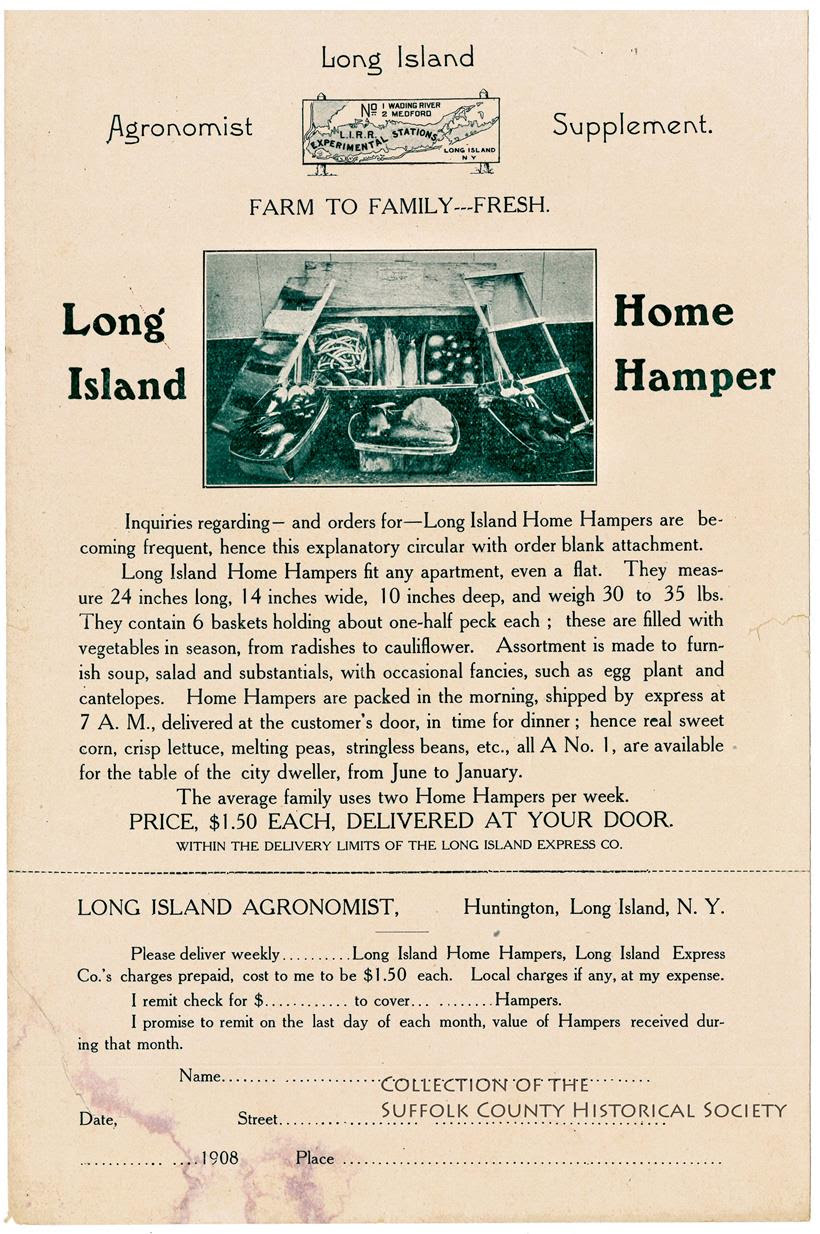
From Farm to Family: The Long Island Home Hamper, 1908. (Image from the Collection of the Suffolk County Historical Society Library Archives. Copyright © Suffolk County HIstorical Society. All rights reserved.)
To market produce grown in the early 1900s at the two Long Island Railroad Experimental Farms in Medford and Wading River, Hal B. Fullerton devised an early form of the modern CSA called Long Island Home Hampers, specially designed crates containing baskets of fresh produce. The crates were packed at the farms with freshly picked seasonal vegetables and fruits, and shipped by the railroad directly to consumers in New York City.
The Home Hamper eliminated the intervention of a merchant in the sales and distribution process and made fresh produce more affordable for middle-class urban residents. Fullerton promoted the Home Hamper as an innovation of national significance, a key to creating a new system for providing fresh, healthy food to city dwellers across the country. Despite promising experimental beginnings at the Wading River and Medford farms, however, the Home Hamper was not widely adopted by Long Island farmers.
Suggested Reading: “The Long Island Home Hamper,” by H. B. Fullerton (Director of Agricultural Development, Long Island Railroad Company), The ANNALS of the American Academy of Political and Social Science, Nov. 1913, vol.50, no. 1, pp. 166-70.
*****************
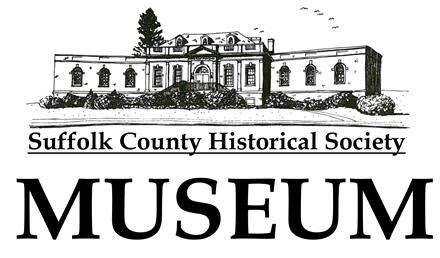

———————————-
Photo of the Week
———- April 26 2021 ———-
FROM THE SCHS LIBRARY ARCHIVES
“How shall we know it is us without our past?”
– John Steinbeck
******************
Robins Island Gun Club House, c. 1890s
by Wendy Polhemus-Annibell, Head Librarian
———————————-
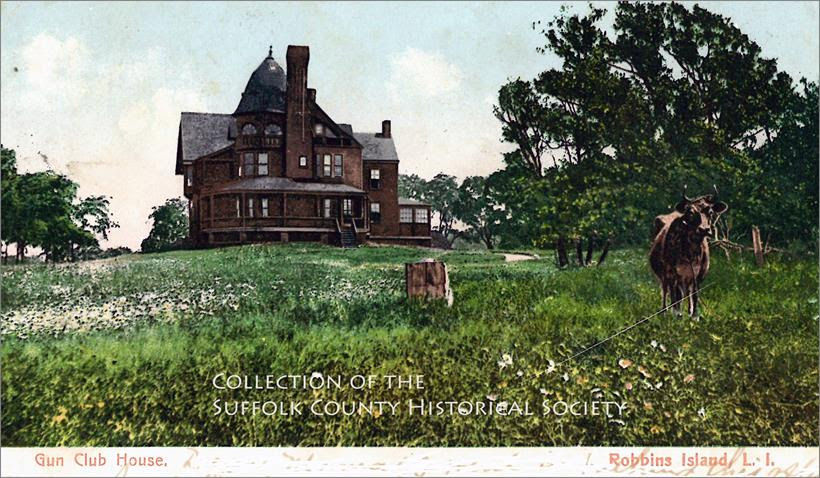
Robins Island Gun Club House, c. 1890s. (Image from the Postcard Collection of the Suffolk County Historical Society Library Archives. Copyright © Suffolk County Historical Society. All rights reserved.)
Having purchased the island in 1881 for $20,000, the Robins Island Gun Club was incorporated that same year for the purpose of “improving and elevating the character of field sports.” Club members, most of them from Brooklyn, paid yearly dues of $100. The club was an exclusive organization limited to 25 members with a waiting list of many dozens more. Prominent Brooklynites Dr. S. Fleet Speir and H.D. Polhemus were elected as the club’s first president and vice president, respectively. During its 36-year tenure, the club had a total of 70 members, including New York City Mayor William Gaynor and New York State Governor Roswell Flowers.
The island was well stocked with pheasants, quail, wild turkeys, and other game birds. Rules of the club included the allowance of 20 birds per member per day, and it was designated where such birds could be shot. Shooting was strictly prohibited on Sundays by New York state law. The pointing of dogs on game, except in October through January, was also prohibited in order to protect birds during their mating season. The club sold Robins Island in 1917 for $95,000, and at that point the club was dissolved.
Suggested Readings: “Robins Island: A Paradise for Local Sportsmen,” Brooklyn Daily Eagle, 8 April 1885; Robins Island Reflections, by Betty Tuthill Wells (2001).
*****************
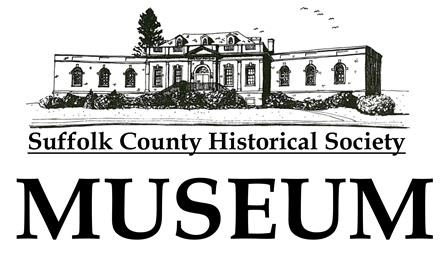

~~~~~~~~~~~~~~~~~~~~~~~~
Photo of the Week
———- April 19, 2021 ———-
FROM THE SCHS LIBRARY ARCHIVES
“How shall we know it is us without our past?”
– John Steinbeck
———–
Vanderbilt Cup Race and Course, 1904
by Wendy Polhemus-Annibell, Head Librarian
———————————-
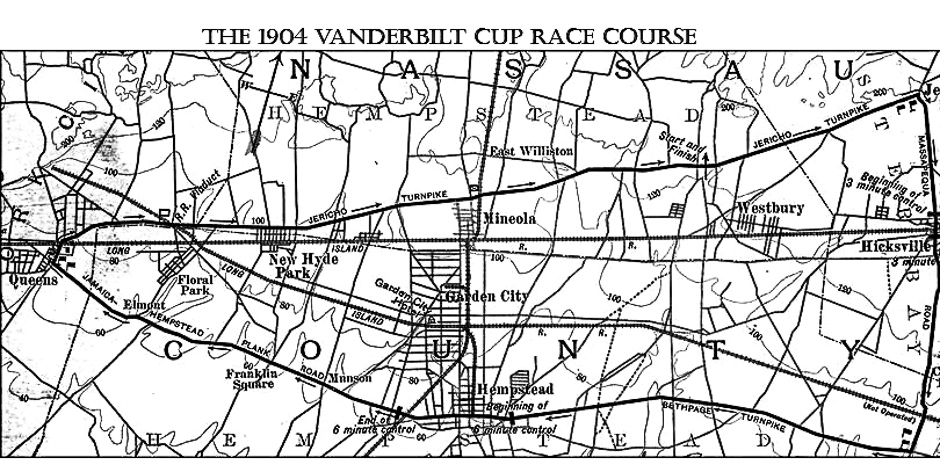
Vanderbilt Cup Race and Course, 1904. Photograph by Hal B. Fullerton taken in Jericho, NY, on October 8, 1904. (Image from the Harry T. Tuthill Fullerton Collection of the Suffolk County Historical Society Library Archives. Copyright © Suffolk County Historical Society. All rights reserved. [To view the Fullerton photograph, please visit the SCHS website.])
The Vanderbilt Cup Race, the first international road race ever held in the United States, took place in Nassau and Queens counties, Long Island, on October 8, 1904. The race course included over 30 miles of public roads, with Jericho Turnpike, Massapequa-Hicksville Road, and Hempstead-Bethpage Turnpike forming its sides. Running clockwise and beginning in Westbury, the roads were connected by turns in Jericho, Plainedge, and Queens. Eighteen racers participated in the first race in 1904, and George Heath’s French Panhard was the first car over the finish line. The popular Vanderbilt Cup races, held on Long Island from 1904 to 1910, were the most prestigious sporting events of their day, drawing huge crowds from 25,000 to over 250,000 spectators.
Suggested Reading: Vanderbilt Cup Races of Long Island, by Howard Kroplick (2008).
~~~~~~~~~~~~~~~~~~~~~~~~~~~~~~~~~~~~
To View 2014 Photo of the Week pages click here.
To View 2015 Photo of the Week pages click here.
To View 2016 Photo of the Week pages click here.
To View 2017 Photo of the Week pages click here.
To View 2018 Photo of the Week pages click here.
To View 2019 Photo of the Week pages click here.
To View 2020 Photo of the Week pages click here.


~~~~~~~~~~~~~~~~~~~~~~~~
Photo of the Week
———- April 12, 2021 ———-
FROM THE SCHS LIBRARY ARCHIVES
“How shall we know it is us without our past?”
– John Steinbeck
———–
Paddock Bro.s’ Plant Catalogue, 1881
by Wendy Polhemus-Annibell, Head Librarian

Spring 1881 Paddock Bro.’s Plant Catalogue.
(Image from the Collection of the Suffolk County Historical Society Library Archives.)
With spring in the air and garden centers filling their shelves with plants for another gardening season we thought it fitting to pull out this 1881 plant catalogue from the Paddock Bro.’s Company of Cleveland, Ohio. It includes a wide variety of plants that were available to gardeners 140 years ago. The introduction to the work makes note of the company’s attempt to meet the increasing demand for horticultural products by adding to their facility a new, large propagating house and greenhouse, a large tank with iron turbine wind-engine for their water supply, and a new packing house.
The product catalogue lists an astonishing 115 different varieties of geraniums, 84 types of old garden roses, and a wide assortment of greenhouse and bedding plants. For $1.00 you could buy 12 beautiful roses, for instance, or 12 geraniums, or a combination of 2 roses, 2 fuchsias, 2 heliotropes, 2 geraniums, 2 cupheas, and 2 carnations. Many other combinations were offered. A collection of 375 plants could be had for $19 including express shipping. The company “made no extra charge” for packing, either by mail or Express, and added extra plants for the “Expressage.”
~~~~~~~~~~~~~~~~~~~~~~~~~~~~~~~~~~~~
To View 2014 Photo of the Week pages click here.
To View 2015 Photo of the Week pages click here.
To View 2016 Photo of the Week pages click here.
To View 2017 Photo of the Week pages click here.
To View 2018 Photo of the Week pages click here.
To View 2019 Photo of the Week pages click here.
To View 2020 Photo of the Week pages click here.


~~~~~~~~~~~~~~~~~~~~~~~~
Photo of the Week
———- April 5, 2021 ———-
FROM THE SCHS LIBRARY ARCHIVES
“How shall we know it is us without our past?”
– John Steinbeck
———–
Lady Suffolk,
Famed Trotting House of the 19th Century
by Wendy Polhemus-Annibell, Head Librarian

Crossroads at Jericho Turnpike, Commack, c. 1840 (top image) and Lady Suffolk at Centreville Course, Long Island, 1849 (lower image). (Top image from a painting by an unknown artist; lower image from a lithograph by N. Currier–both images reprinted in Lady Suffolk, a printed work in the Collection of the Suffolk County Historical Society Library Archives.)
The most famous and beloved trotting horse of the nineteenth century, Lady Suffolk was foaled at the Burr family farm in Commack in 1833. Codman’s Blacksmith Shop (pictured in the lower left portion of the top image) is where Lady Suffolk was often shod during the early years of her career. Her first race was in 1838, when she was five years old. She was campaigned throughout the United States for fifteen years, engaging in 138 races and winning 88 of them!
Halfway through her career Lady Suffolk already held the world record for trotters at the standard distance of one mile, both in harness and under saddle. She had also won the fastest race ever trotted and had broken records in two-mile and three-mile races, including the fastest-ever three-mile race trotted by a mare. Her record was 2.26 minutes for a mile. Lady Suffolk died in 1855 at the age of twenty-two. Some maintain it was for Lady Suffolk that the song “The Old Grey Mare” was written.
Suggested Reading: Lady Suffolk: The Old Grey Mare of Long Island, by John Hervey (New York: Derrydale Press/Piping Rock Horse Show Assoc., 1936).
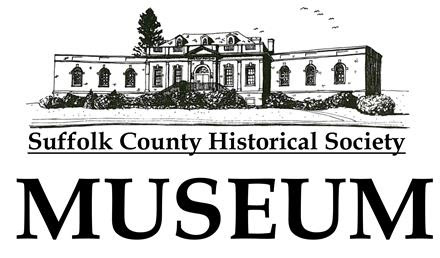

~~~~~~~~~~~~~~~~~~~~~~~~~~~~~~~~~~~~
To View 2014 Photo of the Week pages click here.
To View 2015 Photo of the Week pages click here.
To View 2016 Photo of the Week pages click here.
To View 2017 Photo of the Week pages click here.
To View 2018 Photo of the Week pages click here.
To View 2019 Photo of the Week pages click here.
To View 2020 Photo of the Week pages click here.
~~~~~~~~~~~~~~~~~~~~~~~~
~~~~~~~~~~~~~~~~~~~~~~~~
Photo of the Week
———- March 29, 2021 ———-
FROM THE SCHS LIBRARY ARCHIVES
“How shall we know it is us without our past?”
– John Steinbeck
————————-
Long Island Suffrage Wagon
“Votes for Tomorrow”
by Wendy Polhemus-Annibell, Head Librarian
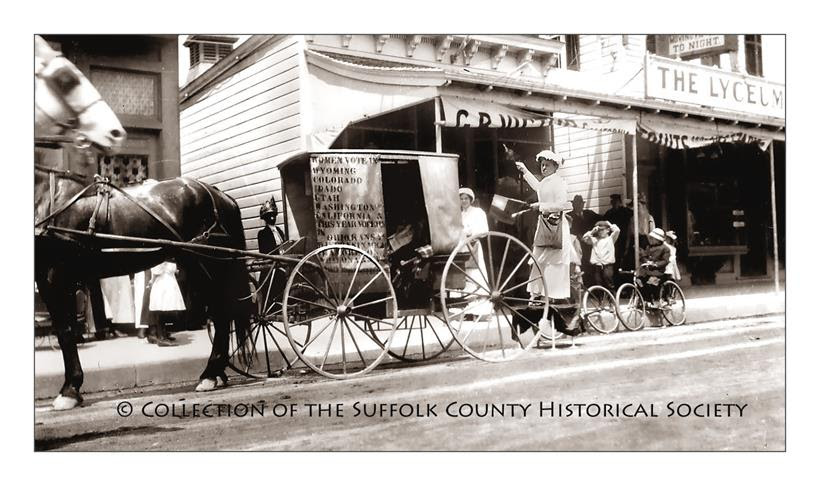 Rosalie Gardiner Jones on the Long Island Suffrage Wagon Advocating “Votes for Tomorrow” (c. 1913). (Image from the Collection of the Suffolk County Historical Society Library Archives. Copyright © Suffolk County Historical Society. All rights reserved.)
Rosalie Gardiner Jones on the Long Island Suffrage Wagon Advocating “Votes for Tomorrow” (c. 1913). (Image from the Collection of the Suffolk County Historical Society Library Archives. Copyright © Suffolk County Historical Society. All rights reserved.)
The wagon’s signage proclaims that women in many other states already had the right to vote, including in “Wyoming, Colorado, Idaho, Utah, Washington, California, and this year in Ohio, Kansas….” New York women would not win the right to vote until 1917.
Rosalie Gardiner Jones (1883-1978) of Cold Spring Harbor became prominent in the suffrage struggle and was dubbed “General Rosalie” owing to her flamboyant and headline-grabbing leadership in the famous suffrage hikes from New York to Albany and New York to Washington. Jones teamed up with Elizabeth Freeman of Kings Park and other suffragists to travel across Suffolk County, through Shoreham, Port Jefferson, Smithtown, and Northport, selling copies of their newspaper, Woman Voter Daily, and selling suffrage literature and buttons to raise funds for the suffrage battle.
Under the headline “Gen. Jones Flies for Suffrage,” the New York Times reported on one of Jones’s stunts in 1913, when she was taken up in a two-seat Wright biplane over Staten Island to toss out yellow Votes for Women leaflets. Jones planned successful suffrage hikes to Albany in 1912 and to Washington, D.C. in 1913. Jones and her “pilgrims” (as they were called) set out for D.C. in 1913, where a large suffrage parade was planned for March 3, the day before the inauguration of the new president, Woodrow Wilson. They carried a banner that read: “Criminals and the insane can’t vote, neither can I, what about it?” Over five thousand women marched down Pennsylvania Avenue on that day to the cheers of onlookers.
~~~~~~~~~~~~~~


~~~~~~~~~~~~~~~~~~~~~~~~~~~~~~~~~~~~
To View 2014 Photo of the Week pages click here.
To View 2015 Photo of the Week pages click here.
To View 2016 Photo of the Week pages click here.
To View 2017 Photo of the Week pages click here.
To View 2018 Photo of the Week pages click here.
To View 2019 Photo of the Week pages click here.
To View 2020 Photo of the Week pages click here.
~~~~~~~~~~~~~~~~~~~~~~~~
~~~~~~~~~~~~~~~~~~~~~~~~
Photo of the Week
———- March 22, 2021 ———-
FROM THE SCHS LIBRARY ARCHIVES
“How shall we know it is us without our past?”
– John Steinbeck
———–
Sayville Shorefront, 1910
by Wendy Polhemus-Annibell, Head Librarian

Sayville Shorefront, 1910. (Image from the Postcard Collection of the Suffolk County Historical Society Library Archives. Copyright © Suffolk County Historical Society. All rights reserved.)
In 1836, fifty years after its initial settlement in circa 1786, Sayville finally got a name. Tired of being called “Over South,” the area’s residents met in the old Bedell Tavern on Main Street to choose a name for the community. The result was a tie among Edwardsville, Greenville, and Judea, which referred to community founders, but then someone suggested Seaville or Seville. This name was adopted but, some local histories assert, the clerk misspelled it as “Sayville.”
Over time, Sayville became a major source of wood for New York City, with an abundant pine forest north of the village; one of the oyster capitals of the United States; a center of Long Island theater arts with the Sayville Opera House; and a bustling summer resort town after the LIRR arrived in 1868. Ten years later, in 1878, when the charter of the Sayville Hook and Ladder Company was signed on top of a grand piano in Columbia Hall, it became the first incorporated company in all of Suffolk County. Today in West Sayville, our island’s maritime history is preserved by our friends at the Long Island Maritime Museum.
Recommended Reading: For more on the history of Sayville, see “A History of Early Sayville,” by Clarissa Edwards (1935), and “East on the Great South Bay: Sayville and Bayport,” by Harry W. Havemeyer (2001).
~~~~~~~~~~~~~~~~~~~~~~~~~~~~~~~~~~~~
To View 2014 Photo of the Week pages click here.
To View 2015 Photo of the Week pages click here.
To View 2016 Photo of the Week pages click here.
To View 2017 Photo of the Week pages click here.
To View 2018 Photo of the Week pages click here.
To View 2019 Photo of the Week pages click here.
To View 2020 Photo of the Week pages click here.
~~~~~~~~~~~~~~~~~~~~~~~~


~~~~~~~~~~~~~~~~~~~~~~~~
Photo of the Week
———- March 15, 2021 ———-
FROM THE SCHS LIBRARY ARCHIVES
“How shall we know it is us without our past?”
– John Steinbeck
———–
Main Street & Fire Island Avenue,
Babylon
by Wendy Polhemus-Annibell, Head Librarian

Main Street & Fire Island Avenue, Babylon. (Image from the Postcard Collection of the Suffolk County Historical Society Library Archives. Copyright © Suffolk County Historical Society. All rights reserved.)
Babylon was originally known as Huntington South when it was part of the Town of Huntington. Farmers would travel from Huntington to the Great South Bay area to harvest salt hay for bedding and feed for their livestock. It was a journey at the time, so the farmers would stay a period of time before returning home. Travelers would also stop at Huntington South on their three-day trip to Southampton from New York City, creating the need for stores and services. Flounder, bluefish, and shellfish were abundant in the bay, providing income and sustenance for the settlers. Fresh streams from the north provided power for mills that produced grain, lumber, and paper. By 1800, Huntington South had become a hub of activity.
Nathaniel Conklin foresaw the area as a thriving town. He built a home for his mother on the northeast corner of Main Street and Deer Park Avenue in 1803. Legend has it that Nathaniel’s mother was unhappy with her home across from a tavern and compared the town with the biblical Babylon. The house now stands on the northwest side of Deer Park Avenue where it was moved in 1871, with a cornerstone that reads “New Babylon, This House Built by Nat Conklin, 1803.” When the railroad arrived in 1867, Huntington South became a thriving resort area. A trolley ran from the depot to the steamship dock where ferries sailed to the Fire Island beaches. At one time there were eleven hotels in the village.
The area called Huntington South became the Town of Babylon with its own governing board in 1872. Soon after, in 1893, the Village of Babylon was incorporated.
~~~~~~~~~~~~~~~~~~~~~~~~~~~~~~~~~~~~
To View 2014 Photo of the Week pages click here.
To View 2015 Photo of the Week pages click here.
To View 2016 Photo of the Week pages click here.
To View 2017 Photo of the Week pages click here.
To View 2018 Photo of the Week pages click here.
To View 2019 Photo of the Week pages click here.
To View 2020 Photo of the Week pages click here.


~~~~~~~~~~~~~~~~~~~~~~~~
Photo of the Week
———- March 8, 2021 ———-
FROM THE SCHS LIBRARY ARCHIVES
“How shall we know it is us without our past?”
– John Steinbeck
———–
Syrena H. Stackpole Elected 1931
by Wendy Polhemus-Annibell, Head Librarian
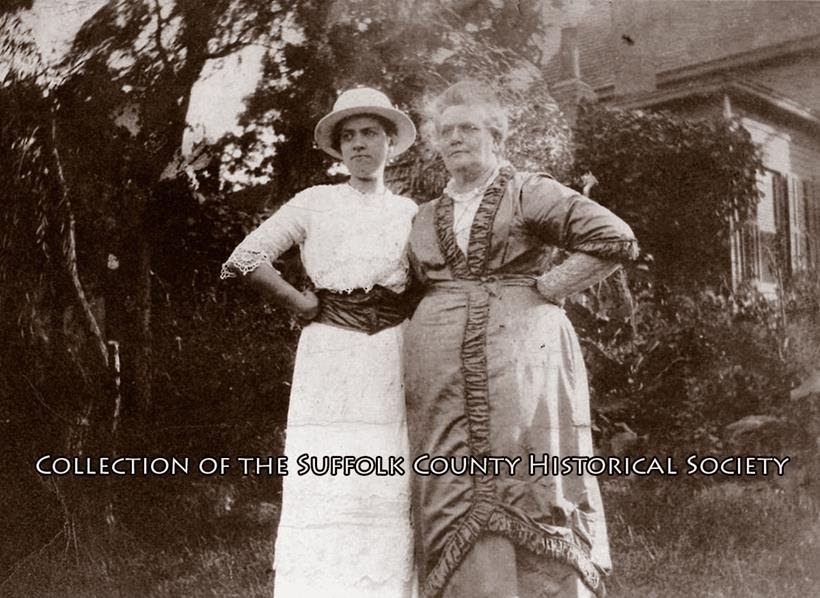
Syrena H. Stackpole of Riverhead, left, with her mother Mary Stackpole, in an undated photograph. (Image from the Collection of the Suffolk County Historical Society Library Archives. Copyright © Suffolk County Historical Society. All rights reserved.)
The Town of Riverhead has the distinction of electing the first woman to hold elected office–Syrena Stackpole–as Justice of the Peace, in 1931, at a time when American women had the right to vote for a mere eleven years.
Syrena H. Stackpole (1888-1983), the 1903 Riverhead High School valedictorian at age 14, was the daughter of attorney George Stackpole and suffragist Mary Stackpole of Riverhead. Earning her bachelor’s degree at Wellesley College, Syrena held various jobs after college–she “taught school, raised chickens and worked as a stenographer, librarian, and secretary”–before returning to school to earn her law degree at New York University School of Law. Ms. Stackpole became the first woman admitted to the Suffolk County Bar Association and the first Suffolk County woman attorney to have her own law practice (which was based in Riverhead).
In another first, Ms. Stackpole was the first woman elected to public office as Justice of the Peace, in Riverhead Town in 1931, which at the time meant she was also a member of the town board. The Democratic State Committee, in a 1931 personal correspondence addressed to Ms. Stackpole, wrote: “The first time that a woman breaks into public office is a landmark in the progress of women, and you have blazed a trail for others to follow.” In recognition of Stackpole’s 1931 victory, fellow Democrat president-elect Franklin Delano Roosevelt, one year later, invited Syrena to the White House on the occasion of his inaugural parade. Ms. Stackpole, who was 42 years old at the time of her historic election, continued to practice law in Riverhead until her early 90s.


~~~~~~~~~~~~~~~~~~~~~~~~~~~~~~~~~~~~
To View 2014 Photo of the Week pages click here.
To View 2015 Photo of the Week pages click here.
To View 2016 Photo of the Week pages click here.
To View 2017 Photo of the Week pages click here.
To View 2018 Photo of the Week pages click here.
To View 2019 Photo of the Week pages click here.
To View 2020 Photo of the Week pages click here.
~~~~~~~~~~~~~~~~~~~~~~~~
Photo of the Week
———- March 1, 2021 ———-
FROM THE SCHS LIBRARY ARCHIVES
“How shall we know it is us without our past?”
– John Steinbeck
———–
Letter from George Washington, 1795
by Wendy Polhemus-Annibell, Head Librarian
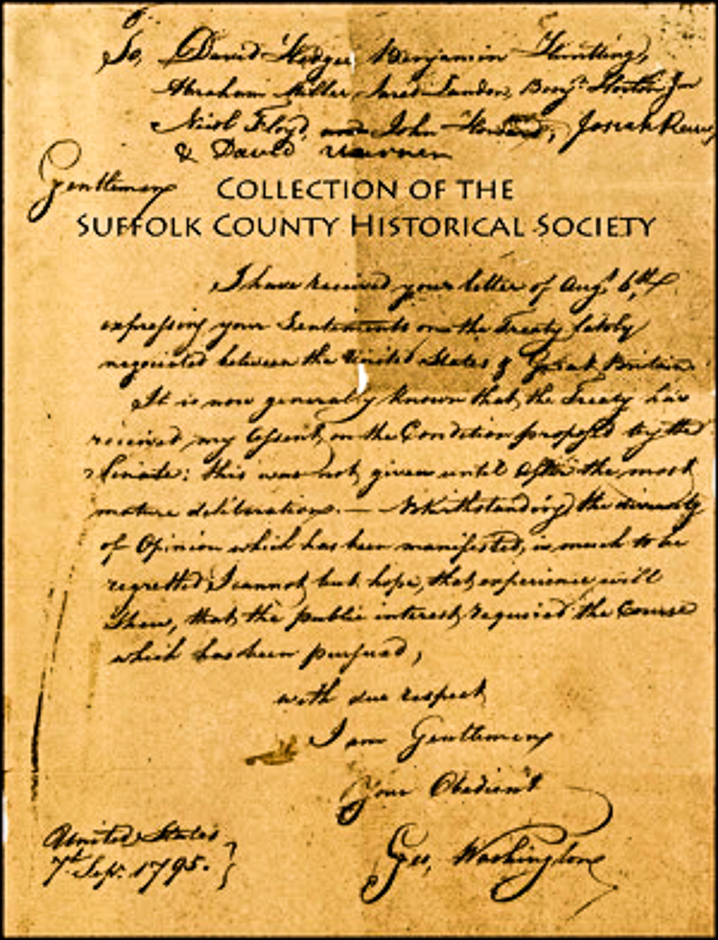
Letter from George Washington to Nine Suffolk County Residents Who Had Expressed Opposition to the Jay Treaty of 1795. (From the Collection of the Suffolk County Historical Society Library Archives. Image Copyright © Suffolk County Historical Society. All rights reserved.)
This rare document from our library archives originally turned up in the Southold home of Mary Dayton, whose ancestors were among New York state’s first judges. The letter, dated September 7, 1795, was addressed to Ms. Dayton’s great-great-great grandfather, Jared Landon of Cutchogue, and eight other Suffolk County residents who had expressed opposition to the Jay Treaty of 1795: David Hedges of Bridgehampton, Benjamin Huntting of Southampton, Abraham Miller of East Hampton, Benjamin Horton Jr. of Southold, Nicoll Floyd of Mastic, John Howard of Shelter Island, Josiah Reeve of Mattituck, and David Warren of Jamesport.
Although we are unsure whether George Washington or a staffer actually penned the letter, it was issued from the president’s office. The letter reads:
“Gentlemen, I have received your letter of Aug 6 expressing your Sentiments on the Treaty lately negotiated between the United States and Great Britain. It is now generally known that the Treaty has received my Assent on the Condition proposed by the Senate; this was not given until after most mature deliberations. Not withstanding the Diversity of Opinion which has been manifested is much to be regretted, I cannot but hope that experience will show that the public interest required the Course which has been pursued. With due respect, I am Gentlemen, Your Obedient Geo. Washington.”
There was anger over Britain’s refusal to withdraw troops from the northwestern frontier, refusal to enter into commercial agreements, and mistreatment of crews on American ships. President George Washington had sent Supreme Court Justice John Jay to negotiate with Britain, and Jay returned with a treaty in which some concessions had been gained, but not nearly as many as the American public had hoped for. The nine Suffolk County residents had sent a letter to Washington expressing doubts about the Jay Treaty that the young United States had recently signed with Great Britain.
Many Long Islanders had been imprisoned or forced to flee to Connecticut during the British occupation, and when they returned, many found that their possessions had been plundered and their homes wrecked by fire or cannonballs. In addition, Washington had been informed that David Hedges had spent seven years in a British lockup in Southampton. The President therefore took special pains to respond personally to these men of Suffolk County.
Suggested Reading: The Diary of George Washington From 1789 to 1791; Embracing the Opening of the First Congress, and His Tours Through New England, Long Island, and the Southern States, 1860.
~~~~~~~~~~~~~~~~~~~~~~~~~~~~~~~~~~~~
To View 2014 Photo of the Week pages click here.
To View 2015 Photo of the Week pages click here.
To View 2016 Photo of the Week pages click here.
To View 2017 Photo of the Week pages click here.
To View 2018 Photo of the Week pages click here.
To View 2019 Photo of the Week pages click here.
To View 2020 Photo of the Week pages click here.
~~~~~~~~~~~~~~~~~~~~~~~~
Photo of the Week
———- January 16, 2021 ———-
FROM THE SCHS LIBRARY ARCHIVES
“How shall we know it is us without our past?”
– John Steinbeck
———–
Civil War Portrait, 1964
by Wendy Polhemus-Annibell, Head Librarian

Elisha Wells Civil War Portrait, 1864. (Image from the Elisha Wells Civil War Collection of the Suffolk County Historical Society Library Archives.)
Elisha Wells (1830-1895) of Aquebogue married Maria Skillman Hudson, and together they had eleven children. During the Civil War, Elisha was a private of Capt. Hubbard E. Tuthill’s Co. 7, 2nd Regiment of Conn., Heavy Artillery Volunteers. He enrolled on February 5, 1864 – at age 33 and with seven children – to serve three years during the Civil War, and was discharged on August 18, 1865. Our library collection includes dozens of letters that he wrote to his wife and family while he was away at war (one of which is transcribed here). Elisha, a Riverhead farmer and a one-time Riverhead Postmaster (1870), is buried in the Riverhead Cemetery.
————
Fort Williams
Near Alexandria, Virginia
April 3, 1864Dear Maria,
I now take the opportunity to inform you that I am in the land of the living yet, and in the enjoyment of good health as good as ever I enjoyed in my life…. The last time I wrote to you I said I thought that we should not have to leave Fort Williams, but that is now somewhat changed. Some two or three regiments have gone to the front and several more have got to go. Among those gone was the 15th New York – they were stationed at Fort Lyons about 1/2 mile to the south of us. They went away last Sunday. They refused to go at first and drew up in battle line. Then the 5th Pennsylvania bucktails encamped close to the city were called upon to take the fort; they marched up to the fort, 2,400 of them, when the New Yorkers thought best to obey orders as they could not have held the fort….
I suppose you know that General [Ulysses S.] Grant was in command of the whole force of the U.S. The soldiers are going South every day to reinforce [General George] Meade for the purpose of the taking of Richmond. Grant is there himself. The Army of the South is in the charge of General [George H.] Thomas. You may expect to hear of some fighting bye and bye. I should like to be at the taking of Richmond; however, there will probably be a great many lives lost in this spring campaign. I expect to stick to it; I believe I am in the right, and I believe the North will conquer the rebels and give them their desserts for they are as bad as the savages. They have been hanging some of our soldiers, maybe you read in the papers. Don’t trouble yourself about me. I can stand my hand with any of them….
My love to all inquiring friends.
From your husband,
E. Wells
~~~~~~~~~~~~~~~~~~~~~~~~~~~~~~~~~~~~
To View 2014 Photo of the Week pages click here.
To View 2015 Photo of the Week pages click here.
To View 2016 Photo of the Week pages click here.
To View 2017 Photo of the Week pages click here.
To View 2018 Photo of the Week pages click here.
To View 2019 Photo of the Week pages click here.
To View 2020 Photo of the Week pages click here.
~~~~~~~~~~~~~~~~~~~~~~~~
Photo of the Week
———- January 9, 2021 ———-
FROM THE SCHS LIBRARY ARCHIVES
“How shall we know it is us without our past?”
– John Steinbeck
———–
LONG ISLAND RAILROAD
by Wendy Polhemus-Annibell, Head Librarian
~~~~~~~~~~~~~~~~~~~~~~~~
LIRR Train to Wading River, 1906, by Hal B. Fullerton. The Port Jefferson line ran to Wading River until the 1960s. (Image from the Harry T. Tuthill Fullerton Collection of the SCHS Library Archives. Copyright © Suffolk County Historical Society. All rights reserved. [To view the Fullerton photo, please visit www.suffolkcountyhistoricalsociety.com website].
—————
LIRR Train to Wading River, 1906, by Hal B. Fullerton. The Port Jefferson line ran to Wading River until the 1960s. (Image from the Harry T. Tuthill Fullerton Collection of the SCHS Library Archives. Copyright © Suffolk County Historical Society. All rights reserved.)
The Long Island Railroad was incorporated nearly 187 years ago, on April 24, 1834, mainly for the purpose of constructing a link from Brooklyn to Boston. Because of New England’s hills and broad rivers, the Greenport route was chosen, and it connected with a steamship line to Stonington, Conn. The extension of the LIRR to Greenport in 1844 was an event that caused much excitement all over Long Island–for now it was possible to make the trip from the western end of Long Island to the eastern end in three hours instead of two to three days!
In the winter of 1843-44 there were a large number of men working on the Greenport line construction. Among them was Michael Creighton, grandfather of Thomas Creighton, flagman on the Griffing Avenue railroad crossing in Riverhead. Also among them was James Magee, grandfather of Barney Magee, blacksmith of Aquebogue. The first train to Greenport was run over the tracks on July 27, 1844. The engines burned wood, mostly pine, which was cut by men with buck saws.
INFO. SOURCE: Clarence Ashton Wood, “First Train to Greenport in 1844” (Long Island Forum, 1944).
~~~~~~~~~~~~~~~~~~
The Suffolk County Historical Society Museum is open to the public for a safe, socially-distanced family outing with 15-minute intervals between parties. Exhibits provide a safe, “touchless” experience for adults and children alike. Masks are required of all museum visitors over age 2.
~~~~~~~~~~~~~~~~~

www.suffolkcountyhistoricalsociety.org
——————-
To View 2014 Photo of the Week pages click here.
To View 2015 Photo of the Week pages click here.
To View 2016 Photo of the Week pages click here.
To View 2017 Photo of the Week pages click here.
To View 2018 Photo of the Week pages click here.
To View 2019 Photo of the Week pages click here.
To View 2020 Photo of the Week pages click here.
———————–


______________________________________________________

